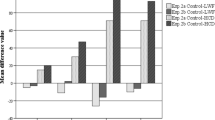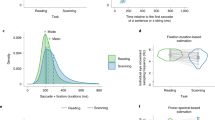Abstract
Eye movements of Chinese readers were recorded for sentences in which high- and low-frequency target words were presented normally or with reduced stimulus quality in two experiments. We found stimulus quality and word frequency produced strong additive effects on fixation durations for target words. The results demonstrate that stimulus quality and word frequency affect different stages of processing (e.g., visual processing and lexical processing). These results are consistent with the findings of previous single-word lexical decision studies, which showed that stimulus quality manipulation primarily affects the early preattentive stage of visual processing, whereas word frequency affects lexical processes. We discuss these findings in terms of the role of stimulus quality in word recognition and in relation to the E-Z Reader model of eye movement control.

Similar content being viewed by others
Notes
http://ccl.pku.edu.cn:8080/ccl_corpus/index.jsp?dir=xiandai. Center for Chinese Linguistics PKU.
References
Balota, D. A., & Abrams, R. A. (1995). Mental chronometry: Beyond onset latencies in the lexical decision task. Journal of Experimental Psychology: Learning, Memory, and Cognition, 21, 1289–1302. doi:10.1037//0278-7393.21.5.1289.
Bangert, A. S., Abrams, R. A., & Balota, D. A. (2012). Reaching for words and nonwords: Interactive effects of word frequency and stimulus quality on the characteristics of reaching movements. Psychonomic Bulletin & Review, 19, 513–520. doi:10.3758/s13423-012-0234-x.
Becker, C. A., & Killion, T. H. (1977). Interaction of visual and cognitive effects in word recognition. Journal of Experimental Psychology: Human Perception and Performance, 3, 389–401. doi:10.1037/0096-1523.3.3.389.
Chinese Lexicon. (2003). [CD-ROM]. Produced by State Key Laboratory of Intelligent Technology and Systems, Tsinghua University and Institute of Automation, Chinese Academy of Sciences. Retrieved from Chinese linguistic Data Consortium. http://www.chineseldc.org/.
Drieghe, D. (2008). Foveal processing and word skipping during reading. Psychonomic Bulletin & Review, 15, 856–860. doi:10.3758/Pbr.15.4.856.
Hoosain, R. (1992). Psychological reality of the word in Chinese. In H. C. Chen & O. J. L. Tzeng (Eds.), Language processing in Chinese (pp. 111–130). North-Holland: Elsevier.
Inhoff, A. W., & Rayner, K. (1986). Parafoveal word processing during eye fixations in reading: Effects of word frequency. Perception and Psychophysics, 40, 431–439.
Jordan, T. R., McGowan, V. A., & Paterson, K. B. (2012). Reading with a filtered fovea: The influence of visual quality at the point of fixation during reading. Psychonomic Bulletin & Review, 19, 1078–1084. doi:10.3758/s13423-012-0307-x.
Li, X., Bicknell, K., Liu, P., Wei, W., & Rayner, K. (2014). Reading is fundamentally similar across disparate writing systems: A systematic characterization of how words and characters influence eye movements in Chinese reading. Journal of Experiment Psychology: General, 143, 895–913. doi:10.1037/a0033580.
Li, X., Rayner, K., & Cave, K. R. (2009). On the segmentation of Chinese words during reading. Cognitive Psychology, 58, 525–552. doi:10.1016/j.cogpsych.2009.02.003.
Liu, P., Li, W., Lin, N., & Li, X. (2013). Do Chinese readers follow the national standard rules for word segmentation during reading? PLoS One, 8, e55440. doi:10.1371/journal.pone.0055440.
McClelland, J. L. (1979). On the time relations of mental processes: An examination of systems of processes in cascade. Psychological Review, 186, 287–330. doi:10.1037/0033-295X.86.4.287.
O’Malley, S., & Besner, D. (2008). Reading aloud: Qualitative differences in the relation between stimulus quality and word frequency as a function of context. Journal of Experimental Psychology: Learning, Memory, and Cognition, 34, 1400–1411. doi:10.1037/A0013084.
O’Malley, S., Reynolds, M. G., & Besner, D. (2007). Qualitative differences between the joint effects of stimulus quality and word frequency in reading aloud and lexical decision: Extension to Yap and Balota (2007). Journal of Experimental Psychology: Learning, Memory, and Cognition, 33, 451–458. doi:10.1037/0278-7393.33.2.451.
Paterson, K. B., McGowan, V. A., & Jordan, T. R. (2012). Eye movements reveal effects of visual content on eye guidance and lexical access during reading. PLoS One, 7, e41766. doi:10.1371/journal.pone.0041766.
Plourde, C. E., & Besner, D. (1997). On the locus of the word frequency effect in visual word recognition. Canadian Journal of Experimental Psychology, 51, 181–194. doi:10.1037/1196-1961.51.3.181.
Pollatsek, A., Reichle, E. D., & Rayner, K. (2006). Tests of the E-Z Reader model: Exploring the interface between cognition and eye-movement control. Cognitive Psychology, 52, 1–56. doi:10.1016/j.cogpsych.2005.06.001.
Rayner, K. (1998). Eye movements in reading and information processing: 20 Years of research. Psychological Bulletin, 124, 372–422. doi:10.1037//0033-2909.124.3.372.
Rayner, K. (2009). Eye movements and attention in reading, scene perception, and visual search. The Quarterly Journal of Experimental Psychology, 62, 1457–1506. doi:10.1080/17470210902816461.
Rayner, K., Li, X., Juhasz, B. J., & Yan, G. (2005). The effect of word predictability on the eye movements of Chinese readers. Psychonomic Bulletin & Review, 12, 1089–1093.
Rayner, K., Li, X., & Pollatsek, A. (2007). Extending the E-Z reader model of eye movement control to Chinese readers. Cognitive Science, 31, 1021–1033.
Rayner, K., Reichle, E. D., Stroud, M. J., & Pollatsek, A. (2006). The effect of word frequency, word predictability, and font difficulty on the eye movements of young and older readers. Psychology and Aging, 21, 448–465. doi:10.1037/0882-7974.21.3.448.
Reichle, E. D., Pollatsek, A., Fisher, D. L., & Rayner, K. (1998). Toward a model of eye movement control in reading. Psychological Review, 105, 125–157. doi:10.1037/0033-295X.105.1.125.
Reichle, E. D., Pollatsek, A., & Rayner, K. (2012). Using E-Z Reader to simulate eye movements in nonreading tasks: A unified framework for understanding the eye-mind link. Psychological Review, 119, 155–185. doi:10.1037/a0026473.
Reichle, E. D., Warren, T., & McConnell, K. (2009). Using E-Z reader to model effects of higher-level language processing on eye movements during reading. Psychonomic Bulletin & Review, 16, 1–21. doi:10.3758/PBR.16.1.1.
Reingold, E. M., & Rayner, K. (2006). Examining the word identification stages hypothesized by the E-Z Reader model. Psychological Science, 17, 742–746. doi:10.1111/j.1467-9280.2006.01775.x.
Reingold, E. M., Yang, J., & Rayner, K. (2010). The time course of word frequency and case alternation effects on fixation times in reading: Evidence for lexical control of eye movements. Journal of Experimental Psychology: Human Perception and Performance, 36, 1677–1683. doi:10.1037/a0019959.
Roberts, S., & Sternberg, S. (1993). The meaning of additive reaction-time effects: Tests of three alternatives. In D. E. Meyer & S. Kornblum (Eds.), Attention and Performance XIV: Synergies in Experimental Psychology, Artificial Intelligence, and Cognitive Neuroscience (pp. 611–653). Cambridge, MA: MIT Press.
Rouder, J. N., Morey, R. D., Speckman, P. L., & Province, J. M. (2012). Default Bayes factors for ANOVA designs. Journal of Mathematical Psychology, 56, 356–374. doi:10.1016/j.jmp.2012.08.001.
Rouder, J. N., Speckman, P. L., Sun, D. C., Morey, R. D., & Iverson, G. (2009). Bayesian t tests for accepting and rejecting the null hypothesis. Psychonomic Bulletin & Review, 16, 225–237. doi:10.3758/Pbr.16.2.225.
Scaltritti, M., Balota, D. A., & Peressotti, F. (2013). Exploring the additive effects of stimulus quality and word frequency: The influence of local and list-wide prime relatedness. Quarterly Journal of Experimental Psychology, 66, 91–107. doi:10.1080/17470218.2012.698628.
Sheridan, H., & Reingold, E. M. (2013). A further examination of the lexical-processing stages hypothesized by the E-Z Reader model. Attention, Perception, & Psychophysics, 75, 407–414. doi:10.3758/s13414-013-0442-0.
Stanners, R. F., Jastrzembski, J. E., & Westbrook, A. (1975). Frequency and visual quality in a word-nonword classification task. Journal of Verbal Learning and Verbal Behavior, 14, 259–264. doi:10.1016/S0022-5371(75)80069-7.
Staub, A. (2011). Word recognition and syntactic attachment in reading: Evidence for a staged architecture. Journal of Experimental Psychology: General, 140, 407–433. doi:10.1037/A0023517.
Sternberg, S. (1969). The discovery of processing stages: Extensions of Donders’ method. Acta Psychologica, 30, 276–315. doi:10.1016/0001-6918(69)90055-9.
Wang, C. A., & Inhoff, A. W. (2010). The influence of visual contrast and case changes on parafoveal preview benefits during reading. Quarterly Journal of Experimental Psychology, 63, 805–817. doi:10.1080/17470210903147494.
Wetzels, R., Grasman, R. P. P. P., & Wagenmakers, E. J. (2012). A default bayesian hypothesis test for ANOVA designs. American Statistician, 66, 104–111. doi:10.1080/00031305.2012.695956.
White, S. J., & Staub, A. (2012). The distribution of fixation durations during reading: Effects of stimulus quality. Journal of Experimental Psychology: Human Perception and Performance, 38, 603–617. doi:10.1037/A0025338.
Yan, G., Tian, H., Bai, X., & Rayner, K. (2006). The effect of word and character frequency on the eye movements of Chinese readers. British Journal of Psychology, 97, 259–268. doi:10.1348/000712605X70066.
Yang, H., & McConkie, G. W. (1999). Reading Chinese: Some basic eye-movement characteristics. In J. Wang, A. W. Inhoff, & H. Chen (Eds.), Reading Chinese script (pp. 207–222). Mahwah, NJ: Lawrence Erlbaum Associates.
Yap, M. J., & Balota, D. A. (2007). Additive and interactive effects on response time distributions in visual word recognition. Journal of Experimental Psychology: Learning, Memory, and Cognition, 33, 274–296. doi:10.1037/0278-7393.33.2.274.
Yap, M. J., Balota, D. A., Tse, C. S., & Besner, D. (2008). On the additive effects of stimulus quality and word frequency in lexical decision: Evidence for opposing interactive influences revealed by RT distributional analyses. Journal of Experimental Psychology: Learning, Memory, and Cognition, 34, 495–513. doi:10.1037/0278-7393.34.3.495.
Acknowledgments
This research was supported by the Knowledge Innovation Program of the Chinese Academic Sciences (KSCX2-YW-BR-6), by a Grant from the Natural Science Foundation of China (31070904), and by a grant from Scientific Foundation of Institute of Psychology, Chinese Academy of Sciences (Y3CX121005). We thank Kevin Paterson for very helpful comments on an earlier version of this article. We thank Keith Rayner and an anonymous reviewer for helpful input on this paper. We also thank Yanping Liu for his helpful comments concerning statistical issues addressed in this article.
Author information
Authors and Affiliations
Corresponding author
Rights and permissions
About this article
Cite this article
Liu, P., Li, X. & Han, B. Additive effects of stimulus quality and word frequency on eye movements during Chinese reading. Read Writ 28, 199–215 (2015). https://doi.org/10.1007/s11145-014-9521-4
Published:
Issue Date:
DOI: https://doi.org/10.1007/s11145-014-9521-4




